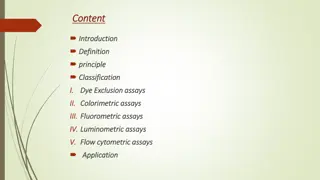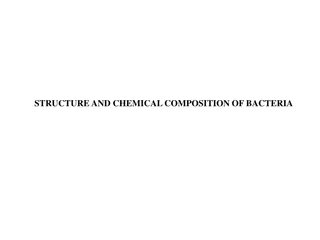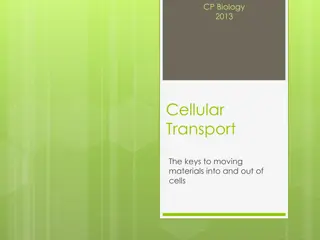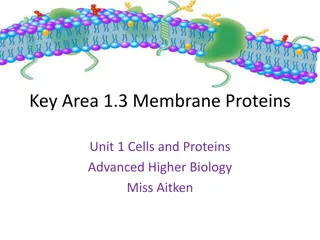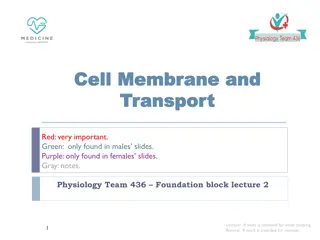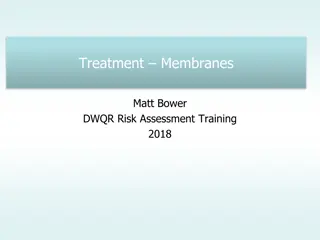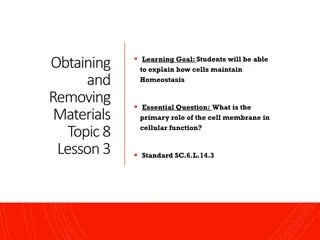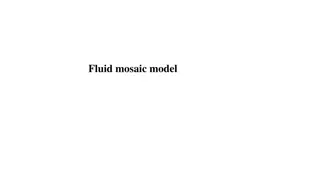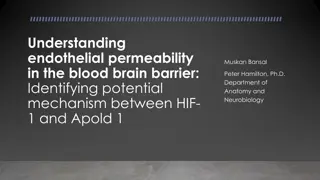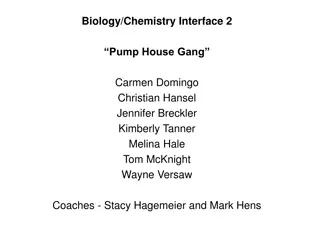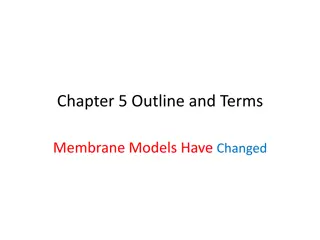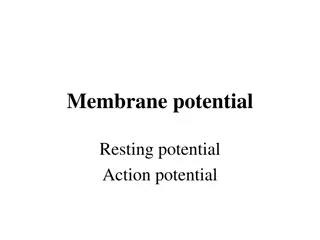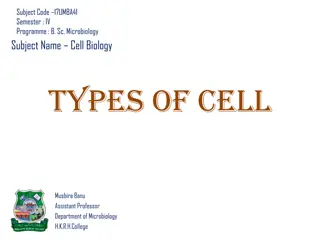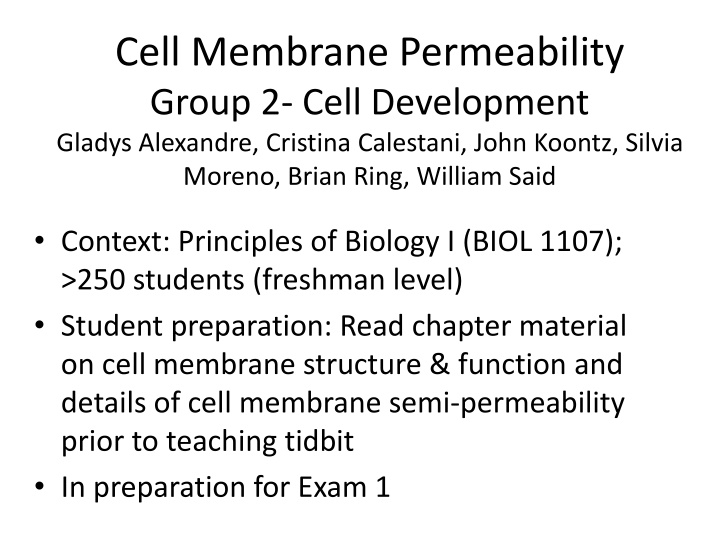
Cell Membrane Permeability and Selective Transport
Explore the principles of cell membrane permeability and selective transport, including the role of selective permeability in phospholipid membrane function. Learn about the concept of selective permeability, predict molecule movement across membranes, and interpret transport kinetics through engaging visuals and scenarios. Discover the significance of semipermeable membranes in allowing specific molecules to pass based on size, charge, and chemical characteristics. Delve into real-world examples like medication absorption with food and compound categorization discussions in a collaborative learning environment.
Download Presentation

Please find below an Image/Link to download the presentation.
The content on the website is provided AS IS for your information and personal use only. It may not be sold, licensed, or shared on other websites without obtaining consent from the author. If you encounter any issues during the download, it is possible that the publisher has removed the file from their server.
You are allowed to download the files provided on this website for personal or commercial use, subject to the condition that they are used lawfully. All files are the property of their respective owners.
The content on the website is provided AS IS for your information and personal use only. It may not be sold, licensed, or shared on other websites without obtaining consent from the author.
E N D
Presentation Transcript
Cell Membrane Permeability Group 2- Cell Development Gladys Alexandre, Cristina Calestani, John Koontz, Silvia Moreno, Brian Ring, William Said Context: Principles of Biology I (BIOL 1107); >250 students (freshman level) Student preparation: Read chapter material on cell membrane structure & function and details of cell membrane semi-permeability prior to teaching tidbit In preparation for Exam 1
Learning Goal Role of Selective Permeability in Phospholipid Membrane Function
Learning Objectives Explain the concept of selective permeability. Predict the movement of molecules across the phospholipid membrane based on their structure. Interpret and graph kinetics of molecule transport across a phospholipid membrane.
Selective Permeability A play
A semipermeable membrane allows... 1. Only small molecules to cross. Only charged molecules to cross. Certain molecules to enter the membrane but not cross to the other side. Molecules to cross the membrane until they reach equal concentration on both sides. Molecules to cross dependent upon their chemical characteristics. 2. 20% 20% 20% 20% 20% 3. 4. 5. 30 1 2 3 4 5 Countdown
Sally went to the doctor for a fever and she was prescribed a sulfa-drug antibiotic. The doctor and her pharmacist insisted that she took her medication with food. Sally wonders why. Why does she have to take the drug with meals? Let s find out
GROUP PROJECT: Discuss and place the compounds under the appropriate category. Write down your reasoning (3 minutes) Fast Slow NO Glycerol Oxygen O2 Sucrose Acetic acid pH 1.5 Acetic acid pH 7.0
GROUP PROJECT: Correct order of compounds. Large polar or charged Non polar Small Polar Fast Slow NO Sucrose Acetic acid pH 1.5 Acetic acid pH 7.0 Oxygen Glycerol O2
Cell membranes are not just made of phospholipids . CellMembraneDrawing Do some molecules need proteins to cross the membrane?
Imagine you are testing the hypothesis of a drug being transported across the cell membrane. Think-Pair-Share: Which of the following compounds enters the cell exclusively by active transport? A + + B + - C - - With ATP Without ATP 1. A 2. B 3. C 0% 0% 0% 30 C B A Countdown
Think-pair-share: Which of the following compounds enters the cell by diffusion? A + + B + - C - - With ATP Without ATP 1. A 2. B 3. C 0% 0% 0% 30 C B A Countdown
If drugs are transported differently through a cell membrane, would you expect the kinetics of transport of these drugs across the cell membrane to be different? Recall covered the characteristics of protein- ligand interactions in kinetics from previous lecture
GROUP PROJECT- 1 minute drill On a paper, each group graph the expected rate of transport of drugs A, B, & C in presence of ATP A B C With ATP + + + - - - Without ATP Rate of transport [Concentration in A, B, C]
GROUP PROJECT- 1 minute drill On a paper, each group graph the expected rate of transport of drugs A, B, & C in presence of ATP A B Rate of transport C [Concentration in A, B, C]
So how about Sallys question and her need to take the sulfa-drug with meals? What is it about the sulfa-drug that could explain why it needs to be taken with meals? GROUP PROJECT- Write down your answer on a paper (1 minute) PH 7 PH 2
An answer- digestion and chemical changes PH 2 PH 7
Learning Objective Assessment Active learning Low Order/ High Order Explain the concept of selective permeability. Clicker Questions Homework Low Order Group Activity 1. Group Chart Activity 2. Documented Problem Solving 1. Group A. Interpret Transport Data Table B. Graph Transport Kinetics C. Group Problem solving 1. High Order 2. High Order Predict the movement of molecules across the phospholipid membrane based on their structure. 1. Group Activities All High Order Interpret and graph kinetics of molecule transport across a phospholipid membrane. Diversity A mix of individual and group active learning assignments in a large lecture classroom setting. Presentation of problems and data in different formats
Summative Assessment 2012 Southeast National Academies Summer Institute May 17, 2012 Group 2: Cell & Development Teachable Unit: Membrane Permeability (Introductory Biology for Majors) Summative Assessment: Exam 1 after formative assessment through homework, group exercises, etc. (see DropBox). Table 1. Transport of molecules across a phospholipid membrane in alien cells. Cellular Conditions N2 Lactose Sulfanilic Acid Plus ATP pH 7.0 + + - No ATP pH 1.5 + + + No ATP pH 7.0 + + - Protein Synthesis Inhibitor + - - Use the above data to answer questions 11-13 below.
Summative Assessment Table 1. Transport of molecules across a phospholipid membrane in alien cells. Cellular Conditions N2 Lactose Sulfanilic Acid Plus ATP pH 7.0 + + - No ATP pH 1.5 + + + No ATP pH 7.0 + + - Protein Synthesis Inhibitor + - - Use the above data to answer questions 11-14 below. 11. What type of cellular transport is demonstrated by Nitrogen gas transport (Table 1)? A) Active Transport B) Facilitated Diffusion C) Passive Transport D) Either B or C E) None of the above.
Summative Assessment Table 1. Transport of molecules across a phospholipid membrane in alien cells. Cellular Conditions N2 Lactose Sulfanilic Acid Plus ATP pH 7.0 + + - No ATP pH 1.5 + + + No ATP pH 7.0 + + - Protein Synthesis Inhibitor + - - Use the above data to answer questions 11-14 below. 12. What type of cellular transport is demonstrated by Lactose transport (Table 1)? A) Active Transport B) Facilitated Diffusion C) Passive Transport D) Either B or C E) None of the above.
Summative Assessment Table 1. Transport of molecules across a phospholipid membrane in alien cells. Cellular Conditions N2 Lactose Sulfanilic Acid Plus ATP pH 7.0 + + - No ATP pH 1.5 + + + No ATP pH 7.0 + + - Protein Synthesis Inhibitor + - - Use the above data to answer questions 11-14 below. 13. Why does the Sulfanilic acid move across the cell membrane (+) at pH 1.5 (Table 1)? A) It s a gas at pH 1.5. B) It s a lipid at pH 1.5. C) Membrane is disordered at pH 1.5. D) It s charged at pH 1.5. E) It s uncharged at pH 1.5.

